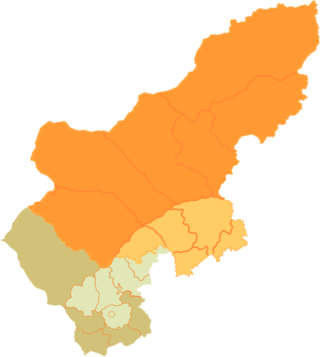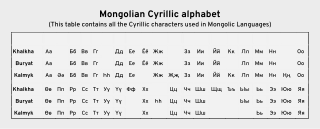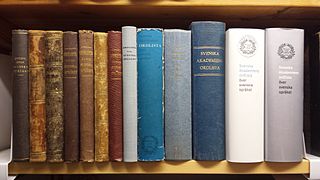Related Research Articles
Tone is the use of pitch in language to distinguish lexical or grammatical meaning—that is, to distinguish or to inflect words. All oral languages use pitch to express emotional and other para-linguistic information and to convey emphasis, contrast and other such features in what is called intonation, but not all languages use tones to distinguish words or their inflections, analogously to consonants and vowels. Languages that have this feature are called tonal languages; the distinctive tone patterns of such a language are sometimes called tonemes, by analogy with phoneme. Tonal languages are common in East and Southeast Asia, Africa, the Americas and the Pacific.

Mongolian is the principal language of the Mongolic language family that originated in the Mongolian Plateau. It is spoken by ethnic Mongols and other closely related Mongolic peoples who are native to modern Mongolia and surrounding parts of East and North Asia. Mongolian is the official language of Mongolia and Inner Mongolia and a recognized language of Xinjiang and Qinghai.

The Mongolic languages are a language family spoken by the Mongolic peoples in Eastern Europe, Central Asia, North Asia and East Asia, mostly in Mongolia and surrounding areas and in Kalmykia and Buryatia. The best-known member of this language family, Mongolian, is the primary language of most of the residents of Mongolia and the Mongol residents of Inner Mongolia, with an estimated 5.7+ million speakers.

Georg Stiernhielm was a Swedish civil servant, mathematician, linguist and poet.

The sj-sound is a voiceless fricative phoneme found in the sound system of most dialects of Swedish. It has a variety of realisations, whose precise phonetic characterisation is a matter of debate, but which usually feature distinct labialization. The sound is represented in Swedish orthography by a number of spellings, including the digraph ⟨sj⟩ from which the common Swedish name for the sound is derived, as well as ⟨stj⟩, ⟨skj⟩, and ⟨sk⟩. The sound should not be confused with the Swedish tj-sound, often spelled ⟨tj⟩, ⟨kj⟩, or ⟨k⟩.

Buryat or Buriat, known in foreign sources as the Bargu-Buryat dialect of Mongolian, and in pre-1956 Soviet sources as Buryat-Mongolian, is a variety of the Mongolic languages spoken by the Buryats and Bargas that is classified either as a language or major dialect group of Mongolian.
Swedish has a large vowel inventory, with nine vowels distinguished in quality and to some degree in quantity, making 18 vowel phonemes in most dialects. Another notable feature is the pitch accent, a development which it shares with Norwegian. Swedish pronunciation of most consonants is similar to that of other Germanic languages.
In geolinguistics, areal features are elements shared by languages or dialects in a geographic area, particularly when such features are not descended from a proto-language, i.e. a common ancestor language. That is, an areal feature is contrasted with lingual-genealogically determined similarity within the same language family. Features may diffuse from one dominant language to neighbouring languages.
Khmu is the language of the Khmu people of the northern Laos region. It is also spoken in adjacent areas of Vietnam, Thailand and China. Khmu lends its name to the Khmuic branch of the Austroasiatic language family, the latter of which also includes Khmer and Vietnamese. Within Austroasiatic, Khmu is often cited as being most closely related to the Palaungic and Khasic languages. The name "Khmu" can also be seen romanized as Kmhmu, Khmu', Kammu, or Khamuk in various publications or alternatively referred to by the name of a local dialect.
The Monguor language is a Mongolic language of its Shirongolic branch and is part of the Gansu–Qinghai sprachbund. There are several dialects, mostly spoken by the Monguor people. A writing system was devised for Huzhu Monguor (Mongghul) in the late 20th century but has been little used.
In phonetics, preaspiration is a period of voicelessness or aspiration preceding the closure of a voiceless obstruent, basically equivalent to an -like sound preceding the obstruent. In other words, when an obstruent is preaspirated, the glottis is opened for some time before the obstruent closure. To mark preaspiration using the International Phonetic Alphabet, the diacritic for regular aspiration, ⟨ʰ⟩, can be placed before the preaspirated consonant. However, Ladefoged & Maddieson (1996:70) prefer to use a simple cluster notation, e.g. ⟨hk⟩ instead of ⟨ʰk⟩.
Iau or Turu is a Lakes Plain language of West Papua, Indonesia, spoken by about 2,100 people, native speakers of this language are the Turu people (Iau). Most speakers are monolingual, and their number is growing. Other peoples in the western Lakes Plain area speak basic Iau. Iau is heavily tonal, with 11 tones on nouns and 19 simple and compound tones on verbs.

The Majang language is spoken by the Majangir people of Ethiopia. Although it is a member of the Surmic language cluster, it is the most isolated one in the group. A language survey has shown that dialect variation from north to south is minor and does not seriously impede communication. The 2007 Ethiopian Census lists 6,433 speakers for Majang (Messengo), but also reports that the ethnic group consists of 32,822 individuals. According to the census, almost no speakers can be found in Mezhenger Zone of Gambela Region; a total of eleven speakers are listed for the zone, but almost 10,000 ethnic Mejenger or Messengo people.

Chakhar is a variety of Mongolian spoken in the central region of Inner Mongolia. It is phonologically close to Khalkha and is the basis for the standard pronunciation of Mongolian in Inner Mongolia.
Primarily in Austroasiatic languages, in a typical word a minor syllable is a reduced (minor) syllable followed by a full tonic or stressed syllable. The minor syllable may be of the form or, with a reduced vowel, as in colloquial Khmer, or of the form with no vowel at all, as in Mlabri 'navel' and 'underneath', and Khasi kyndon 'rule', syrwet 'sign', kylla 'transform', symboh 'seed' and tyngkai 'conserve'. This iambic pattern is sometimes called sesquisyllabic, a term coined by the American linguist James Matisoff in 1973.
Baarin is a dialect of Mongolian spoken mainly in Inner Mongolia.

The Mongolian Cyrillic alphabet is the writing system used for the standard dialect of the Mongolian language in the modern state of Mongolia. It has a largely phonemic orthography, meaning that there is a fair degree of consistency in the representation of individual sounds. Cyrillic has not been adopted as the writing system in the Inner Mongolia region of China, which continues to use the traditional Mongolian script.

Swedish orthography is the set of rules and conventions used for writing Swedish. The primary authority on Swedish orthography is Svenska Akademiens ordlista (SAOL), a spelling dictionary published by the Swedish Academy. The balance between describing the language and creating norms has changed with the years.
O is a letter of related and vertically oriented alphabets used to write Mongolic and Tungusic languages.